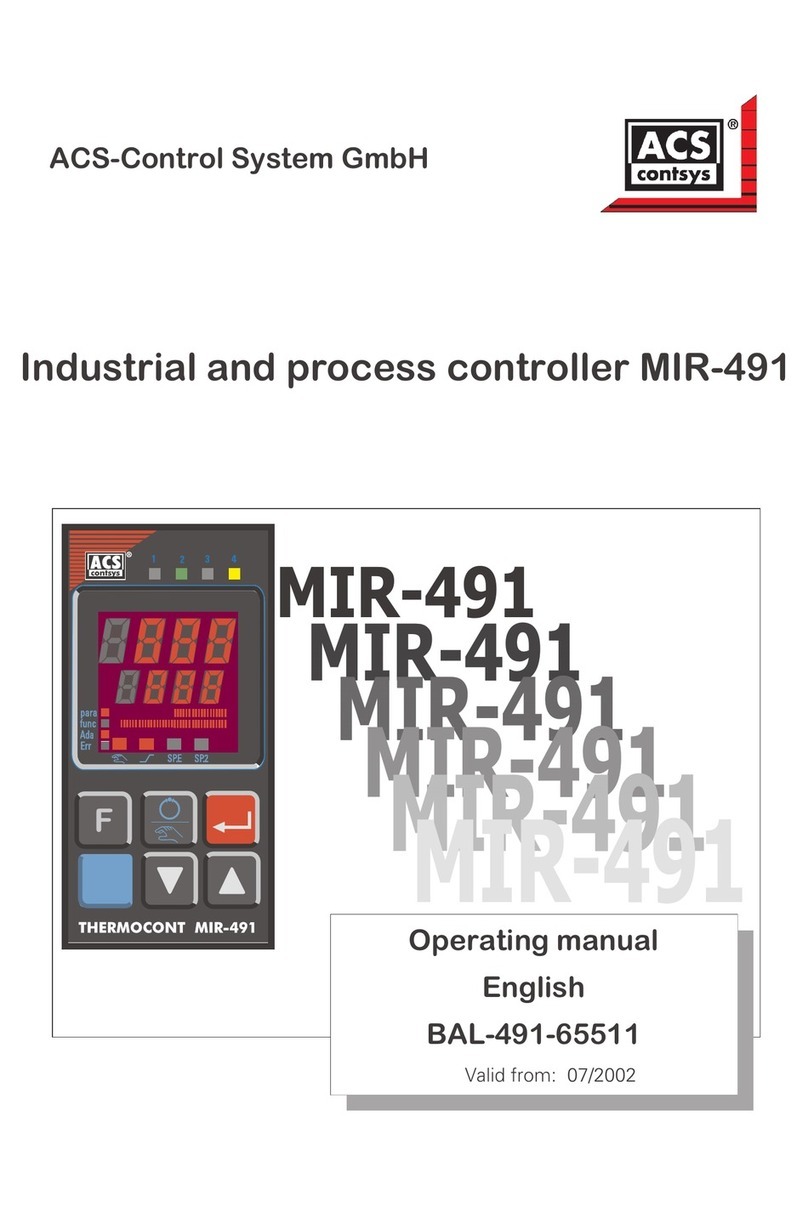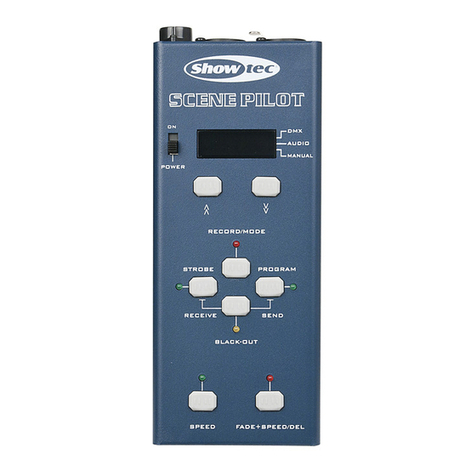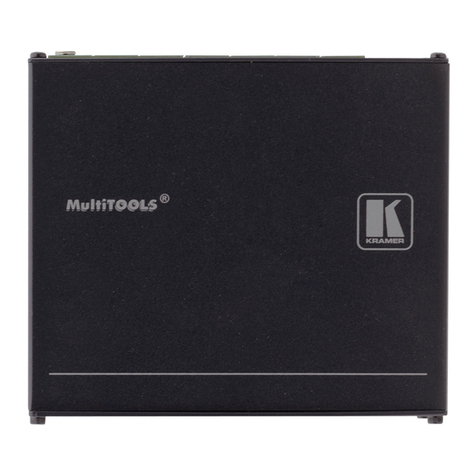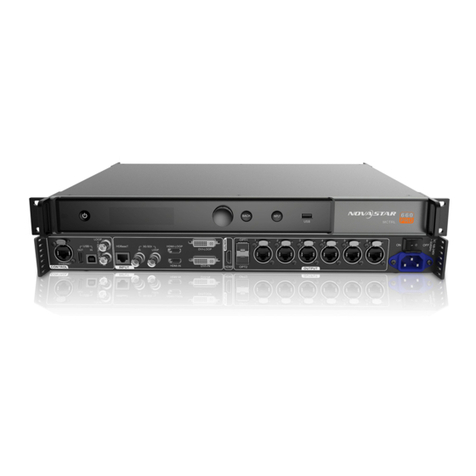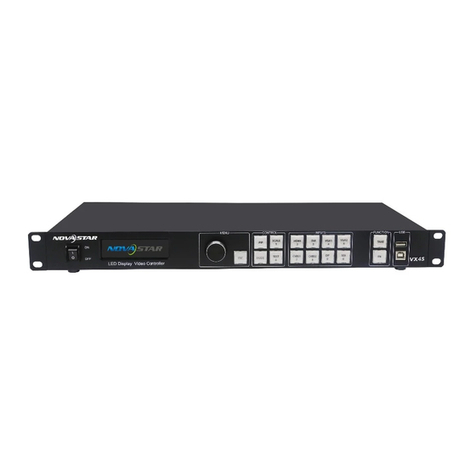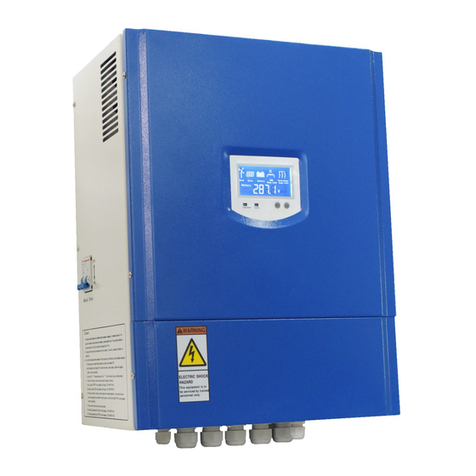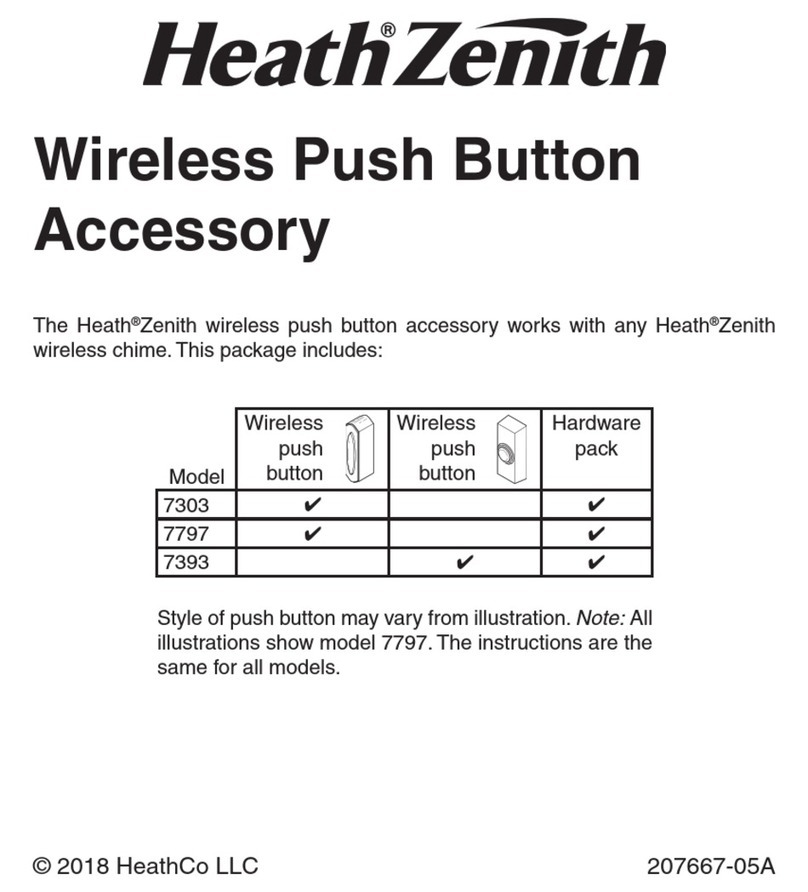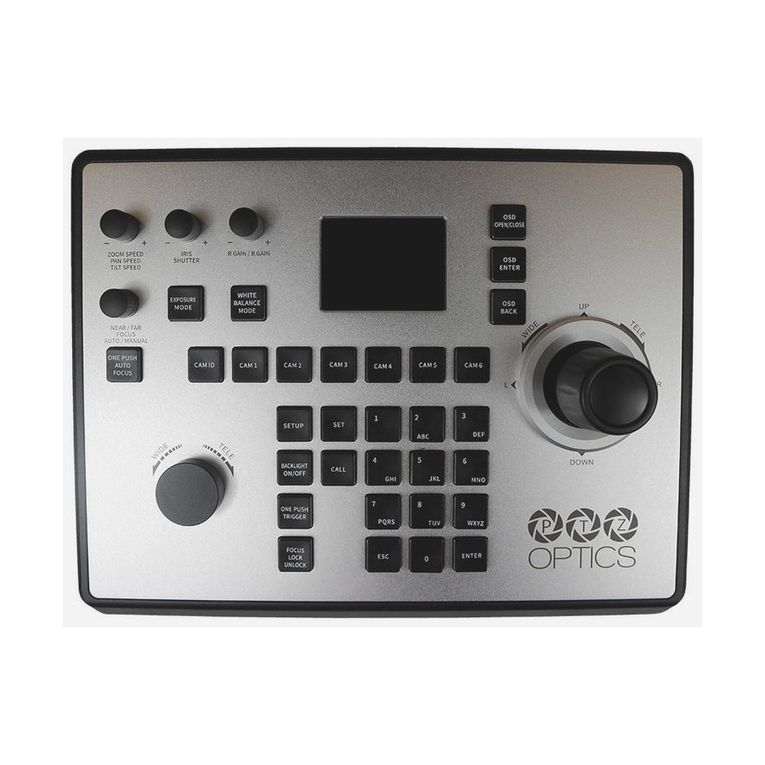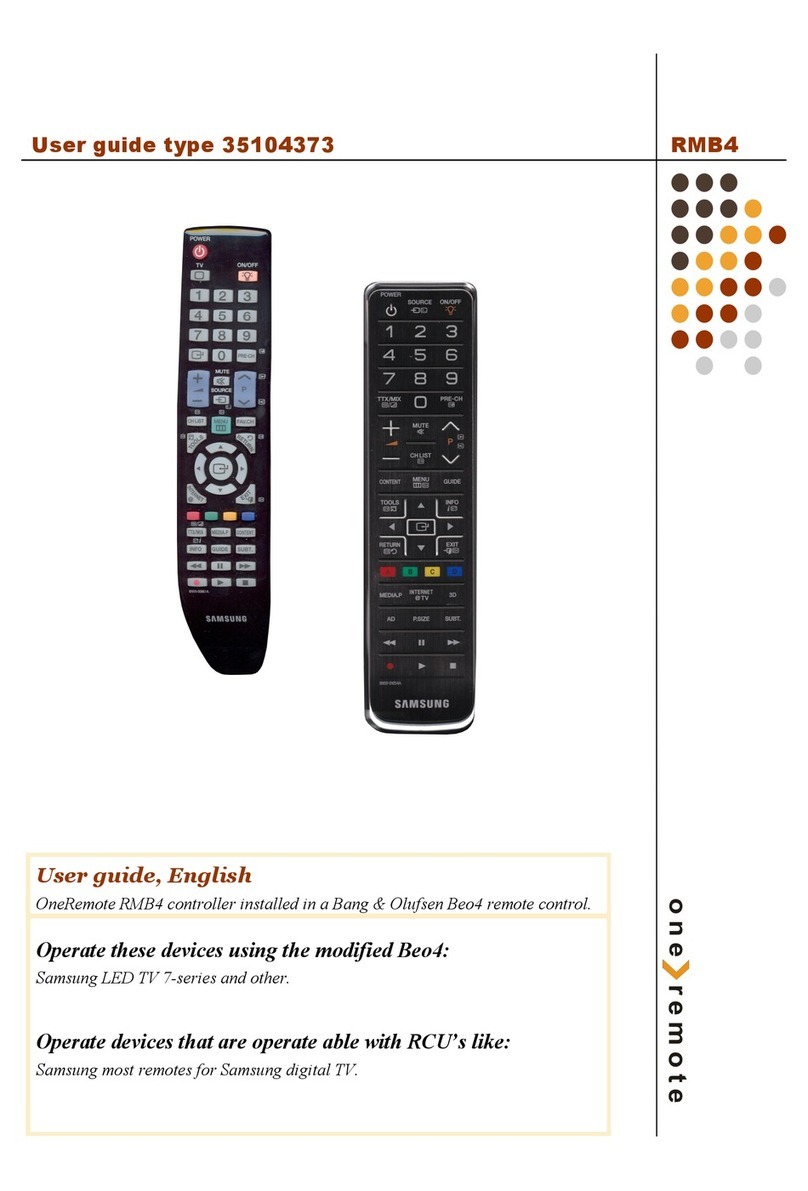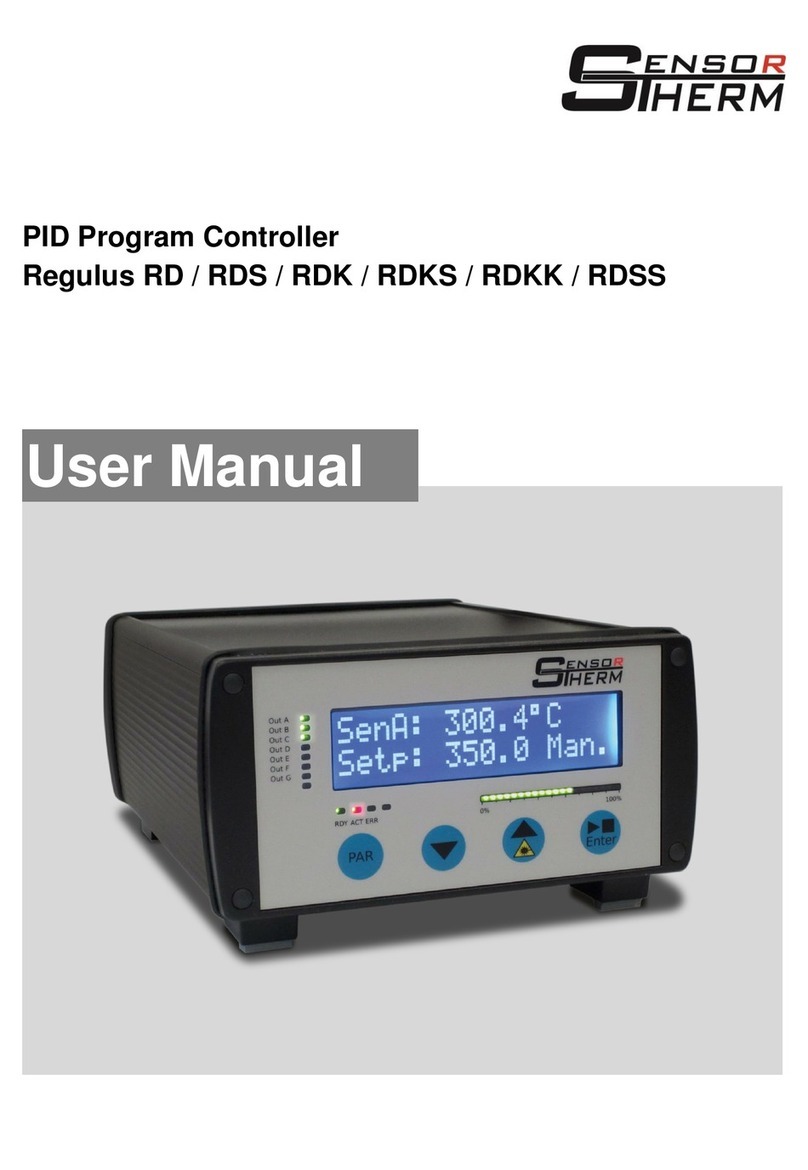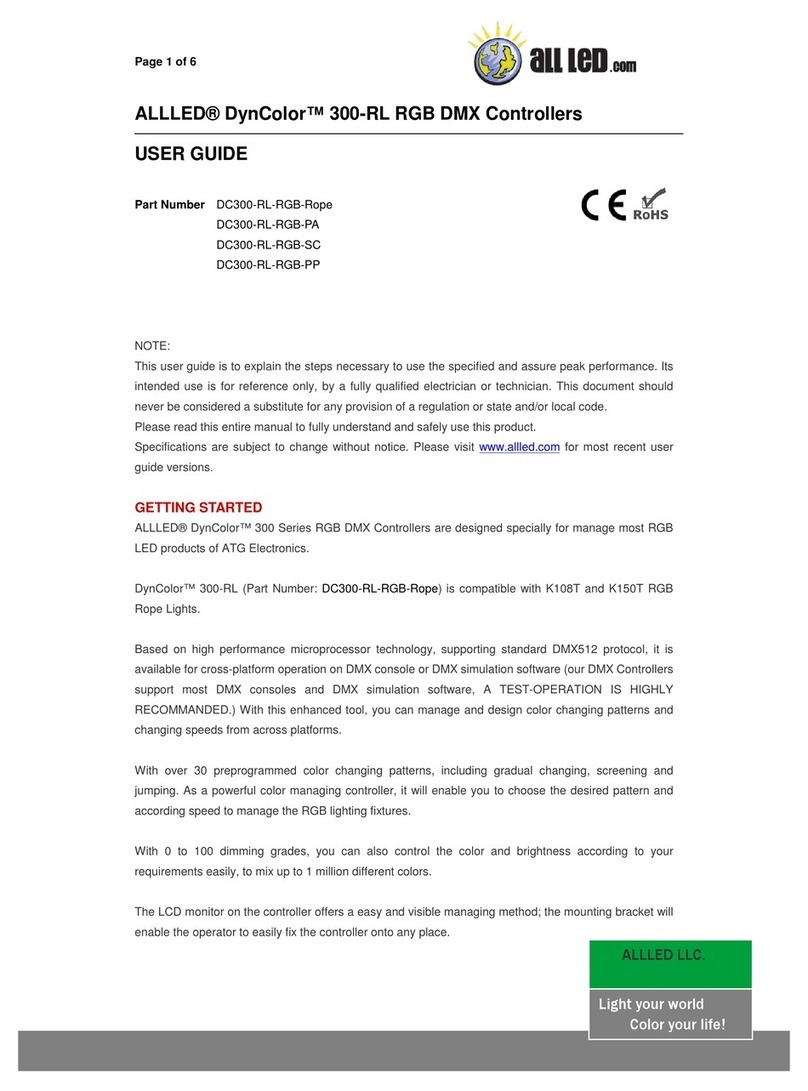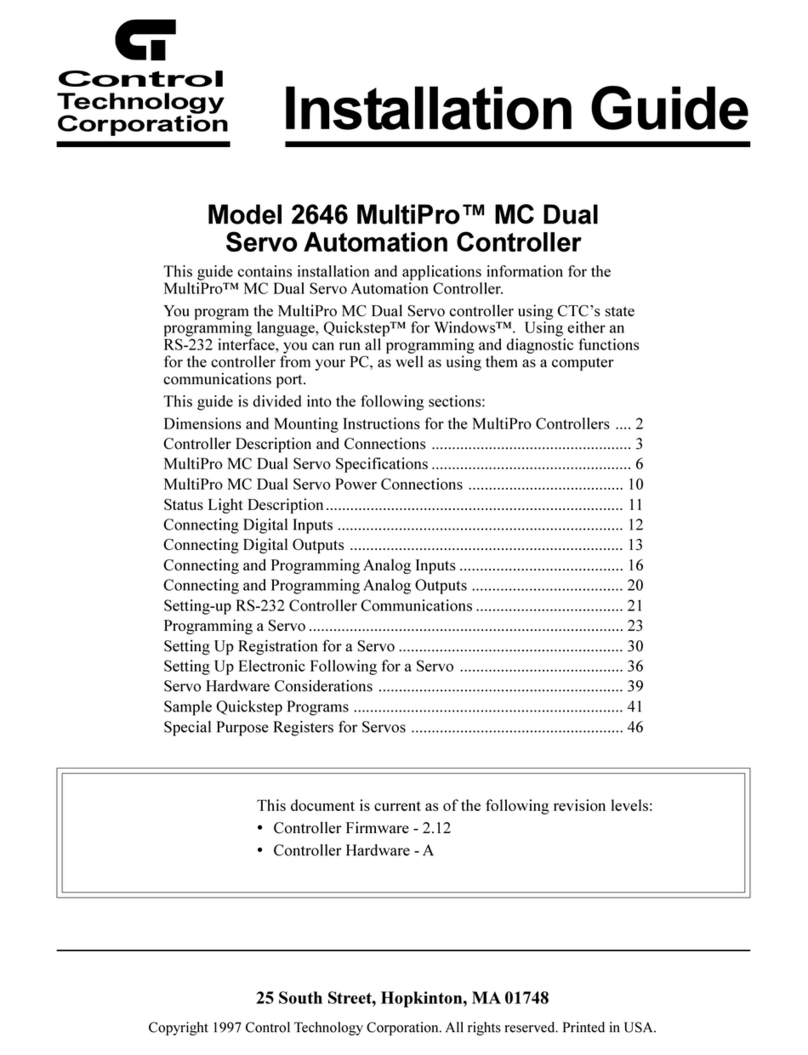ACS contsys MIR-491 User manual

Operating Instructions
MIR-491 and MIR-492
Industrial- and process controller
MIR-491
MIR-492

ACS-CONTROL-SYSTEM GmbH l Lauterbachstr. 57 l D-84307 Eggenfelden l www.acs-controlsystem.de l [email protected]
2
© PMA Prozeß- und Maschinen-Automation GmbH •Printed in Germany
All rights reserved. No part of this document may bereproduced or published in any form
or by any means without prior written permission from the copyright owner.
A publication of PMA Prozeß- und Maschinen Automation
P.O.Box 310229
D-34058 Kassel
Germany
ûBlueControl
More efficiency in engineering,
more overview in operating:
The projecting environment for the BluePort®controllers
ATTENTION!
Mini Version and Updates on
or on PMA-CD
www.pma-online.de
Description of symbols
in the text: on the device:
gGeneral information aFollow the operating instructions
aGeneral warning
lAttention: ESD-sensitive devices
© PMA Prozeß- und Maschinen-Automation GmbH •Printed in Germany
All rights reserved. No part of this document may bereproduced or published in any form
or by any means without prior written permission from the copyright owner.
A publication of PMA Prozeß- und Maschinen Automation
P.O.Box 310229
D-34058 Kassel
Germany
ûBlueControl
More efficiency in engineering,
more overview in operating:
The projecting environment for the BluePort®controllers
ATTENTION!
Mini Version and Updates on
or on PMA-CD
www.pma-online.de
Description of symbols
in the text: on the device:
gGeneral information aFollow the operating instructions
aGeneral warning
lAttention: ESD-sensitive devices

ACS-CONTROL-SYSTEM GmbH l Lauterbachstr. 57 l D-84307 Eggenfelden l www.acs-controlsystem.de l [email protected] 3
KS 90-1 / KS 92-1 3
Contents
1Mounting.............................. 5
2Electrical connections . . . . . . . . . . . . . . . . . . . . . . . 6
2.1 Connecting diagram . . . . . . . . . . . . . . . . . . . . . . . 6
2.2 Terminal connection . . . . . . . . . . . . . . . . . . . . . . . . 7
3Operation............................. 11
3.1 Frontview ............................ 11
3.2 Behaviour after power-on . . . . . . . . . . . . . . . . . . . . . 12
3.3 Operatinglevel .......................... 12
3.4 Error list / Maintenance manager . . . . . . . . . . . . . . . . . 13
3.5 Self-tuning............................. 16
3.5.1 Preparation for self-tuning . . . . . . . . . . . . . . . . . . . 16
3.5.2 Optimization after start-up or at the set-point . . . . . . . . . 17
3.5.3 Selecting the method ( ConF/Cntr/tunE).........17
3.5.4 Step attempt after start-up . . . . . . . . . . . . . . . . . . 18
3.5.5 Pulse attempt after start-up . . . . . . . . . . . . . . . . . . . 18
3.5.6 Optimization at the set-point ..................18
3.5.7 Optimization at the set-point for 3-point stepping controller. . 20
3.5.8 Self-tuning start . . . . . . . . . . . . . . . . . . . . . . . . . 21
3.5.9 Self-tuning cancellation. . . . . . . . . . . . . . . . . . . . . 21
3.5.10 Acknowledgement procedures in case of
unsuccessful self-tuning . . . . . . . . . . . . . . . . . . . . 22
3.5.11 Examples for self-tuning attempts . . . . . . . . . . . . . . . 23
3.6 Manualself-tuning......................... 24
3.7 Second PID parameter set . . . . . . . . . . . . . . . . . . . . . 25
3.8 Alarmhandling .......................... 26
3.9 Operating structure . . . . . . . . . . . . . . . . . . . . . . . . 28
4Configurationlevel........................ 29
4.1 Configuration survey . . . . . . . . . . . . . . . . . . . 29
4.2 Configuration parameters . . . . . . . . . . . . . . . . . . . 30
4.3 Set-point processing . . . . . . . . . . . . . . . . . . . . . . . . 44
4.3.1 Set-point gradient / ramp . . . . . . . . . . . . . . . . . . . . 44
4.4 Switching behaviuor . . . . . . . . . . . . . . . . . . . . . . . . 45
4.4.1 Standard ( CyCl=0).....................45

ACS-CONTROL-SYSTEM GmbH l Lauterbachstr. 57 l D-84307 Eggenfelden l www.acs-controlsystem.de l [email protected]
4
4 KS 90-1 / KS 92-1
4.4.2 Switching attitude linear ( CyCl=1).............45
4.4.3 Switching attitude non-linear ( CyCl=2) ..........46
4.4.4 Heating and cooling with constant period ( CyCl=3) . . . . 47
4.5 Configuration examples . . . . . . . . . . . . . . . . . . . . . . 48
4.5.1 On-Off controller / Signaller (inverse) . . . . . . . . . . . . . 48
4.5.2 2-point controller (inverse) . . . . . . . . . . . . . . . . . . . 49
4.5.3 3-point controller (relay & relay) . . . . . . . . . . . . . . . . 50
4.5.4 3-point stepping controller (relay & relay) . . . . . . . . . . . 51
4.5.5 Continuous controller (inverse) . . . . . . . . . . . . . . . . . 52
4.5.6 Y - Off controller / 2-point controller with pre-contact . 53
4.5.7 Continuous controller with position controller . . . . . . . . 54
4.5.8 Measured value output . . . . . . . . . . . . . . . . . . . . . 55
5Parameter setting level . . . . . . . . . . . . . . . . . . . . . . 56
5.1 Parametersurvey ....................... 56
5.2 Parameters............................. 57
5.3 Inputscaling............................ 60
5.3.1 Input Inp.1 and InP.3...........60
5.3.2 Input InP.2 ..........................60
6Calibrationlevel......................... 61
7Specialfunctions......................... 64
7.1 DAC®– motor actuator monitoring ...............64
7.2 O2measurement.......................... 66
7.2.1 Connection...........................66
7.2.2 Configuration:..........................67
7.3 Linearization............................ 68
7.4 Loopalarm............................. 69
7.5 Heating current input / heating current alarm . . . . . . . . . . . 69
7.6 KS9x-1 as Modbus master. . . . . . . . . . . . . . . . . . . . . 70
7.7 Back-up controller (PROFIBUS) . . . . . . . . . . . . . . . . . 70
8BlueControl............................ 71
9Versions.............................. 72
10 Technical data .......................... 74
11 Safetyhints............................ 78
11.1 Resetting to factory setting, . . . . . . . . . . . . . . . . . . . . 80
MIR-49x as Modbus master.

ACS-CONTROL-SYSTEM GmbH l Lauterbachstr. 57 l D-84307 Eggenfelden l www.acs-controlsystem.de l [email protected] 5
1Mounting
aFix the instrument only at top and bottom to avoid damaging it.
Safety switch:
For access to the safety switch, the controller must be withdrawn from the hou-
sing. Squeeze the top and bottom of the front bezel between thumb and forefinger
and pull the controller firmly from the housing.
1Factory setting 2Default setting: display of all levels
suppressed, password PASS =OFF
lCaution! The unit contains ESD-sensitive components.
Mounting
KS 90-1 / KS 92-1 5
%
max.
95% rel.
max. 60°C
0°Cmin.
96 (3.78")
48 (1.89")
Loc
min.48 (1.89")
10 (0.4")
1..10
(0.04..0.4")
118 (4.65")
45 +0,6
(1.77" )
+0.02
92
+0,8
(3.62" )
+0.03
Ü
*
KS 90-1
advanced
1 2 3
è
1200
1199
°C
°F
SP.2
SP.E
para
func
Ada
Err
4
1200
1199
°C
°F
SP.2
SP.E
para
func
Ada
Err
1234
F
KS 92-1 advanced
F
92+0,8
92
+0,8
96
96
10
118
1234
KS 92-1 advanced
F
SP.E
SP.2
run
920.1
921.2
C
para
func
Ada
Err
SP.E
SP.2
run
o
locking switch
Loc open Access to the levels is as adjusted by means of BlueControl(engineering tool) 2
closed 1all levels accessible wihout restriction
1Mounting
aFix the instrument only at top and bottom to avoid damaging it.
Safety switch:
For access to the safety switch, the controller must be withdrawn from the hou-
sing. Squeeze the top and bottom of the front bezel between thumb and forefinger
and pull the controller firmly from the housing.
1Factory setting 2Default setting: display of all levels
suppressed, password PASS =OFF
lCaution! The unit contains ESD-sensitive components.
Mounting
KS 90-1 / KS 92-1 5
%
max.
95% rel.
max. 60°C
0°Cmin.
96 (3.78")
48 (1.89")
Loc
min.48 (1.89")
10 (0.4")
1..10
(0.04..0.4")
118 (4.65")
45 +0,6
(1.77" )
+0.02
92
+0,8
(3.62" )
+0.03
Ü
*
KS 90-1
advanced
1 2 3
è
1200
1199
°C
°F
SP.2
SP.E
para
func
Ada
Err
4
1200
1199
°C
°F
SP.2
SP.E
para
func
Ada
Err
1234
F
KS 92-1 advanced
F
92+0,8
92
+0,8
96
96
10
118
1234
KS 92-1 advanced
F
SP.E
SP.2
run
920.1
921.2
C
para
func
Ada
Err
SP.E
SP.2
run
o
locking switch
Loc open Access to the levels is as adjusted by means of BlueControl(engineering tool) 2
closed 1all levels accessible wihout restriction
MIR-491 MIR-492

ACS-CONTROL-SYSTEM GmbH l Lauterbachstr. 57 l D-84307 Eggenfelden l www.acs-controlsystem.de l [email protected]
6
2Electrical connections
2.1 Connecting diagram
gDependent of order, the controller is fitted with :
wflat-pin terminals 1 x 6,3mm or 2 x 2,8mm to DIN 46 244 or
wscrew terminals for 0,5 to 2,5mm²
On instruments with screw terminals, the insulation must be stripped by min.
12 mm. Choose end crimps accordingly!
Electrical connections
Connecting diagram 6 KS 90-1 / KS 92-1
1
3
4
5
6
7
8
9
10
11
12
13
14
15
17
(2)
(16)
mA
(mV)
(mV)
Volt
mA
INP2
INP3
INP1
di2
di1
1
2
3
4
5
6
7
8
9
10
11
12
13
14
15
Option
1
2
3
4
5
6
7
8
9
10
11
12
13
14
15
17
(16)
OUT1
OUT2
OUT3
OUT4
90...250V
24 V UC
0%
100%
V
V
mA
HC
KS90-1. -2
5
...
KS90-1. -4...
KS90-1. -5...
KS90-1..-.1...
di2
di3
UT
RXD-B
GND
RXD-A
TXD-B
TXD-A
RS485 RS422
Modbus RTU
RGND
DATA B
DATA A
9
0
8
3
2
17
6
5
4
abc d e
f
g
a
bc
d
e
+24V DC
24V GND
OUT5
OUT6
!
VP (5V)
DGND
RxD/TxD-N
RxD/TxD-P
PROFIBUS-DP
Schirm/
Screen
5
9
4
8
3
7
2
6
1
5
9
4
8
3
7
2
6
1
390 [
390 [
220 [
DGND
VP (5V)
max.
1200m
Adapter
Profibus DP
MIR-49x-1.4...
MIR-49x-1.5...
MIR-49x-1.2...
MIR-49x-1...-1...

ACS-CONTROL-SYSTEM GmbH l Lauterbachstr. 57 l D-84307 Eggenfelden l www.acs-controlsystem.de l [email protected] 7
2.2 Terminal connection
Power supply connection 1
See chapter "Technical data"
Connection of outputs OUT1/2 2
Relay outputs (250V/2A), potential-free
changeover contact
Connection of outputs OUT3/4 3
arelay (250V/2A), potential-free
changeover contact
universal output
bcurrent (0/4...20mA)
cvoltage (0/2...10V)
dtransmitter supply
elogic (0..20mA / 0..12V)
Connection of input INP1 4
Input mostly used for variable x1 (pro-
cess value)
athermocouple
bresistance thermometer (Pt100/ Pt1000/ KTY/ ...)
ccurrent (0/4...20mA)
dvoltage (0/2...10V)
Connection of input INP2 5
fheating current input (0..50mA AC)
or input for ext. set-point (0/4...20mA)
gpotentiometer input for position
feedback
Connection of input INP2 5
aHeating current input (0...50mA AC)
or input for ext. Set-point (0/4...20mA)
bPotentiometer input for position
feedback
Connection of input INP3 6
As input INP1, but without voltage
Connection of inputs di1, di2 7
Digital input, configurable as switch or
push-button
Electrical connections
KS 90-1 / KS 92-1 7 Terminal connection
6
9
10
11
12
13
14
15
1
2
3
4
5
6
7
8
9
10
11
12
13
14
17
(16)
L
N
+
5
43
2
1
8
7
15
2OUT1/2 heating/cooling
L
N
+
_
SSR
3
4
5
6
9
10
11
12
13
14
15
1
2
3
4
5
8
9
10
11
12
13
14
15
17
(16)
2
1
8
7
6
7
Logik
5INP2 current tansformer

ACS-CONTROL-SYSTEM GmbH l Lauterbachstr. 57 l D-84307 Eggenfelden l www.acs-controlsystem.de l [email protected]
8
Connection of inputs di2/3 8(option)
Digital inputs (24VDC external), galvanically isolated, configurable as switch or
push-button
Connection of output UT9(option)
Supply voltage connection for external energization
Connection of outputs OUT5/6 0(option)
Digital outputs (opto-coupler), galvanic isolated, common positive control volta-
ge, output rating: 18...32VDC
Connection of bus interface !(option)
PROFIBUS DP or RS422/485 interface with Modbus RTU protocol
gAnalog outputs OUT3 or OUT4 and transmitter supply UTare connected to
different voltage potentials. Therefore, take care not to make an external galvanic
connection between OUT3/4 and UTwith analog outputs!
Electrical connections
Terminal connection 8 KS 90-1 / KS 92-1
13
14
15
Option
17
(16)
1
3
4
5
6
7
8
9
10
11
12
13
14
15
17
(2)
(16)
+24VDC
5mA
5mA
0V
1
2
3
K
+
-
+
-
17,5V
22mA
14
13
+
-
15
OUT3
10
11
12
J
J
8 9 di2/3, 2-wire transmitter supply

ACS-CONTROL-SYSTEM GmbH l Lauterbachstr. 57 l D-84307 Eggenfelden l www.acs-controlsystem.de l [email protected] 9
* Interface description Modbus RTU in separate manual: see page 72.
Electrical connections
KS 90-1 / KS 92-1 9 Terminal connection
1
2
3
K
+
-
+
-
13V
22mA
13
14
15
11
12 13
17
(16)
14 15
12
11
10
3OUT3 transmitter supply
1
3
4
5
6
7
8
9
10
11
12
13
14
15
17
(2)
(16)
option
1
3
4
5
6
7
8
9
10
11
12
13
14
15
17
(2)
(16)
option
1
3
4
5
6
7
8
9
10
11
12
13
14
15
17
(2)
(16)
option
11
12
13
14
15
10
11
12
13
14
15
10
11
12
13
14
15
RGND RGND RGND
RT
RS485-RS232
converter
PC
DATA A
DATA B
DATA A
DATA B
DATA A
DATA B
J
max. 1000m
"Twisted Pair” cable
10
RT
R=100 Ohm
RGND connection optional
R = 120...200 OhmT
R = 120...200 OhmT
9RS485 interface (with RS232-RS485 interface converter) *

ACS-CONTROL-SYSTEM GmbH l Lauterbachstr. 57 l D-84307 Eggenfelden l www.acs-controlsystem.de l [email protected]
10
KS9x-1 connecting example:
aCAUTION: Using a temperature limiter is recommendable in systems where
overtemperature implies a fire hazard or other risks.
Electrical connections
Terminal connection 10 KS 90-1 / KS 92-1
12
+
_
SSR
+
_
SSR
+
_
SSR
Series connection
Parallel connection
+
_
SSR
+
_
SSR
4V
4V
4V 12V
I =22mA
max
I =22mA
max
12V 11
10
10
11
12
Logic
3OUT3 as logic output with solid-state relay (series and parallel connection)
+
_
L1
L2
N1
N2
Fuse
1
2
3
4
7
5
8
6
9
10
11
12
13
14
15
Fuse
1
Fuse
SSR
Reset-
key
Contactor
Heating
1TB 40-1 Temperaturelimiter
Standard-version (3 Relays):
TB40-100-0000D-000
further versions on requestr
++
3
4
5
6
7
8
9
11
13
14
15
1
2
3
4
5
6
7
8
9
10
11
12
13
14
17
(16)
15
2
1
12
10
Logik
KS90-1
TB 40-1
Temperaturelimiter
KS9x-1 connecting example:
aCAUTION: Using a temperature limiter is recommendable in systems where
overtemperature implies a fire hazard or other risks.
Electrical connections
Terminal connection 10 KS 90-1 / KS 92-1
12
+
_
SSR
+
_
SSR
+
_
SSR
Series connection
Parallel connection
+
_
SSR
+
_
SSR
4V
4V
4V 12V
I =22mA
max
I =22mA
max
12V 11
10
10
11
12
Logic
3OUT3 as logic output with solid-state relay (series and parallel connection)
+
_
L1
L2
N1
N2
Fuse
1
2
3
4
7
5
8
6
9
10
11
12
13
14
15
Fuse
1
Fuse
SSR
Reset-
key
Contactor
Heating
1TB 40-1 Temperaturelimiter
Standard-version (3 Relays):
TB40-100-0000D-000
further versions on requestr
++
3
4
5
6
7
8
9
11
13
14
15
1
2
3
4
5
6
7
8
9
10
11
12
13
14
17
(16)
15
2
1
12
10
Logik
KS90-1
TB 40-1
Temperaturelimiter
MIR-49x
Anschlussbeispiel MIR-49x:

ACS-CONTROL-SYSTEM GmbH l Lauterbachstr. 57 l D-84307 Eggenfelden l www.acs-controlsystem.de l [email protected] 11
3Operation
3.1 Front view
1Statuses of switching outputs OuT.1... 62Process value display
3Setpoint or correcting variable display 4°C or °F display signalling
5Signals ConF- and PArA level 6Signals activated function key
7Selft-tuning active 8Entry into the error list
9Bargraph or plain text display 0Setpoint SP.2 is effective
!Setpoint SP.E is effective "Setpoint gradient is effective
§Manual-automatic switchover: Off: automatic On: manual mode (adjustment possible)
Blinks: manual mode (adjustment not possible (rConF/Cntr/MAn))
$Enter key: call up extented operating level / error list
%Up/ down keys: changing setpoint or correcting variable
&automatic/manual or other functions ( rConF/LOGI)
/freely configurable function key with pure controller operation
(PC connection for BlueControl (engineering tool)
LED colours: LED 1, 2, 3, 4: yellow, Bargraph: red, other LEDs: red
gIn the upper display line, the process value is always displayed. At parameter,
configuration, calibration as well as extended operating level, the bottom display
line changes cyclically between parameter name and parameter value.
Operation
KS 90-1 / KS 92-1 11 Front view
123 4
F
SP.E
SP.2
920.1
921.2
C
para
func
Ada
Err
SP
.E
SP
.2
o
1200
1199
°C
°F
SP.2
SP.E
para
func
Ada
Err
F
1 2 3 4
A
(
1
2
3
4
5
6
$
7
8
%
&
(
/
p
f
9
0
!
§ "
!
2
5
3
4
C
9
0
!
!
§ "
Err
7
8
$
%
&
/
(
6
5
5
6
1
2
3

ACS-CONTROL-SYSTEM GmbH l Lauterbachstr. 57 l D-84307 Eggenfelden l www.acs-controlsystem.de l [email protected]
12
3.2 Behaviour after power-on
After supply voltage switch-on, the unit starts with the operating level.
The unit is in the condition which was active before power-off.
If the controller was in manual mode at supply voltage switch-off, the controller
will re-start with the last output value in manual mode at power-on.
3.3 Operating level
The content of the extended operating level is determined by means of BlueCon-
trol (engineering tool). Parameters which are used frequently or the display of
which is important can be copied to the extended operating level.
Operation
Behaviour after power-on 12 KS 90-1 / KS 92-1
Ò
Ò
Ù
Ù
Ù
Ù
Automatic
Extended operating level
Manual
i
i
only
display
switching
Display
Error list (if error exists)
Y 21
1199
1200
1199
È
Ì
È
Ì
Y 21
1199
1200
1199
È
Ì
FbF.1
126
Err
2
126
Err
time
out
time
out
time
out

ACS-CONTROL-SYSTEM GmbH l Lauterbachstr. 57 l D-84307 Eggenfelden l www.acs-controlsystem.de l [email protected] 13
3.4 Error list / Maintenance manager
With one or several errors, the extended operating le-
vel always starts with the error list. Signalling an ac-
tual entry in the error list (alarm, error) is done by the
Err LED in the display. To reach the error list press
Ùtwice.
Error list:
Operation
KS 90-1 / KS 92-1 13 Error list / Maintenance manager
1200
1199
°C
°F
SP.2
SP.E
para
func
Ada
Err
Err LED status Signification Proceed as follows
blinks
(status 2)Alarm due to
existing error - Determine the error type in the error list
- After error correction the unit changes to status 1
lit
(status 1)Error removed,
alarm not
acknowledged
- Acknowledgethealarmintheerrorlistpressingkey ÈorÌ
- The alarm entry was deleted (status 0).
off
(status 0)No error, all alarm
entries deleted - -Not visible except when acknowledging
Name Description Cause Possible remedial action
E.1 Internal error,
cannot be
removed
- E.g. defective EEPROM - Contact PMA service
- Return unit to our factory
E.2 Internal error,
can be reset - e.g. EMC trouble - Keep measurement and power supply
cables in separate runs
- Ensure that interference suppression
of contactors is provided
E.3 Configuration
error,
can be reset
- wrong configuration
- missing configuration
- Check interaction of configuration /
parameters
E.4 Hardware error - Codenumber and hardware
are not identical
- Contact PMA service
- Elektronic-/Optioncard must be
exchanged
FbF.
1/2/3Sensor break
INP1/2/3 - Sensor defective
- Faulty cabling
- Replace INP1/2/3 sensor
- Check INP1/2/3 connection
Sht.
1/2/3Short circuit
INP1/2/3 - Sensor defective
- Faulty cabling
- Replace INP1/2/3 sensor
- Check INP1/2/3 connection
POL.
1/2/3INP1/2/3
polarity error - Faulty cabling - Reverse INP1/2/3 polarity
HCA Heating current
alarm (HCA) - Heating current circuit
interrupted, I< HC.A or
I> HC.A (dependent of
configuration)
- Heater band defective
- Check heating current circuit
- If necessary, replace heater band
- Service kontaktieren
- Gerät einschicken
- Service kontaktieren

ACS-CONTROL-SYSTEM GmbH l Lauterbachstr. 57 l D-84307 Eggenfelden l www.acs-controlsystem.de l [email protected]
14
gSaved alarms (Err-LED is lit) can be acknowledged and deleted with the digital
input di1/2/3, the è-key or the Ò-key.
Configuration, see page 37: ConF /LOGI /Err.r
gIf an alarm is still valid that means the cause of the alarm is not removed so far
(Err-LED blinks), then other saved alarms can not be acknowledged and deleted.
Operation
Error list / Maintenance manager 14 KS 90-1 / KS 92-1
Name Description Cause Possible remedial action
SSr Heating current
short circuit
(SSR)
- Current flow in heating
circuit with controller off
- SSR defective
- Check heating current circuit
- If necessary, replace solid-state relay
LooP Control loop
alarm (LOOP) - Input signal defective or not
connected correctly
- Output not connected
correctly
- Check heating or cooling circuit
- Check sensor and replace it, if
necessary
- Check controller and switching
device
AdA.H Self-tuning
heating alarm
(ADAH)
- See Self-tuning heating
error status
- see Self-tuning heating error status
AdA.C Self-tuning
heating alarm
cooling (ADAC)
- See Self-tuning cooling
error status
- see Self-tuning cooling error status
dAC DAC-Alarm Actor error see errorstatus DAC-function
LiM.1/
2/3stored limit
alarm 1/2/3 - adjusted limit value 1/2/3
exceeded
- check process
Inf.1 time limit value
message - adjusted number of
operating hours reached
- application-specific
Inf.2 duty cycle
message
(digital ouputs)
- adjusted number of duty
cycles reached
- application-specific
E.5 Internal error in
DP module self-test errorinternal
communication interrupted Switch on the instrument
againContact PMA service
dp.1 No access by bus
master bus errorconnector
problemno bus connection Check cableCheck connectorCheck
connections
dp.2 Faulty
configuration Faulty DP configuration
telegram Check DP configuration telegram in
master
dp.3 Inadmissible
parameter
setting telegram
sent
Faulty DP parameter
setting telegram Check DP parameter setting
telegram in master
dp.4 No data
communication Bus errorAddress
errorMaster stopped Check cable connectionCheck
addressCheck master setting
- Service kontaktieren

ACS-CONTROL-SYSTEM GmbH l Lauterbachstr. 57 l D-84307 Eggenfelden l www.acs-controlsystem.de l [email protected] 15
Self-tuning heating ( ADA.H) and cooling ( ADA.C) error status:
DAC function ( DAC) error status:
Operation
KS 90-1 / KS 92-1 15 Error list / Maintenance manager
Error status Description Behaviour
0No error
3Output is blocked Check the drive for blockage
4Wrong method of operation Wrong phasing, defect motor capacitor
5Fail at Yp measurement Check the connection to the Yp input
6Calibration error Manual calibration necessary
Error
status Description Behaviour
0No error
3Faulty control
action Re-configure controller (inverse idirect)
4No response of
process variable The control loop is perhaps not closed: check sensor,
connections and process
5Low reversal point Increase ( ADA.H) max. output limiting Y.Hi or decrease (
ADA.C) min. output limiting Y.Lo
6Danger of exceeded
set-point (parameter
determined)
If necessary, increase (inverse) or reduce (direct) set-point
7Output step change
too small (dy > 5%) Increase ( ADA.H) max. output limiting Y.Hi or reduce (
ADA.C) min. output limiting Y.Lo
8Set-point reserve too
small Acknowledgment of this error message leads to switch-over to
automatic mode.If self-tuning shall be continued,
increase set-point (invers), reduce set-point (direct)
or decrease set-point range
(rPArA /SEtp /SP.LO and SP.Hi )

ACS-CONTROL-SYSTEM GmbH l Lauterbachstr. 57 l D-84307 Eggenfelden l www.acs-controlsystem.de l [email protected]
16
3.5 Self-tuning
For determination of optimum process parameters, self-tuning is possible.
After starting by the operator, the controller makes an adaptation attempt, where-
by the process characteristics are used to calculate the parameters for fast line-out
to the set-point without overshoot.
The following parameters are optimized when self-tuning:
Parameter set 1:
Pb1 - Proportional band 1 (heating) in engineering units [e.g. °C]
ti1 - Integral time 1 (heating) in [s]ronly, unless set to OFF
td1 - Derivative time 1 (heating) in [s]ronly, unless set to OFF
t1 - Minimum cycle time 1 (heating) in [s]ronly, unless Adt0 was
set to “no self-tuning” during configuration by means of
BlueControl®.
Pb2 - Proportional band 2 (cooling) in engineering units [e.g. °C]
ti2 - Integral time 2 (cooling) in [s]ronly, unless set to OFF
td2 - Derivative time 2 (cooling) in [s]ronly, unless set to OFF
t2 - Minimum cycle time 2 (cooling) in [s] ronly, unless Adt0
was set to “no self-tuning” during configuration by means of
BlueControl®.
Parameter set 2: analogous to parameter set 1 (see page 25)
3.5.1 Preparation for self-tuning
wAdjust the controller measuring range as control range limits. Set values
rnG.L and rnG.H to the limits of subsequent control.
(ConfigurationrControllerrlower and upper control range limits)
ConFrCntrrrnG.L and rnG.H
wDetermine which parameter set shall be optimized.
-The instantaneously effective parameter set is optimized.
rActivate the relevant parameter set (1 or 2).
wDetermine which parameter set shall be optimized (see tables above).
wSelect the self-tuning method
see chapter 3.5.3
-Step attempt after start-up
-Pulse attempt after start-up
-Optimization at the set-point
Operation
Self-tuning 16 KS 90-1 / KS 92-1

ACS-CONTROL-SYSTEM GmbH l Lauterbachstr. 57 l D-84307 Eggenfelden l www.acs-controlsystem.de l [email protected] 17
3.5.2 Optimization after start-up or at the set-point
The two methods are optimization after start-up and at the set-point.
As control parameters are always optimal only for a limited process range, vari-
ous methods can be selected dependent of requirements. If the process behaviour
is very different after start-up and directly at the set-point, parameter sets 1 and 2
can be optimized using different methods. Switch-over between parameter sets
dependent of process status is possible (see page ).
Optimization after start-up: (see page 4)
Optimization after start-up requires a certain separation between process value
and set-point. This separation enables the controller to determine the control pa-
rameters by evaluation of the process when lining out to the set-point.
This method optimizes the control loop from the start conditions to the set-point,
whereby a wide control range is covered.
We recommend selecting optimization method “Step attempt after start-up”
with tunE = 0 first. Unless this attempt is completed successfully, we recom-
mend a “Pulse attempt after start-up”.
Optimization at the set-point: (see page 18)
For optimizing at the set-point, the controller outputs a disturbance variable to the
process. This is done by changing the output variable shortly. The process value
changed by this pulse is evaluated. The detected process parameters are conver-
ted into control parameters and saved in the controller.
This procedure optimizes the control loop directly at the set-point. The advantage
is in the small control deviation during optimization.
3.5.3 Selecting the method ( ConF/Cntr/tunE)
Selection criteria for the optimization method:
Step attempt after start-up Pulse attempt after
start-up Optimization at the
set-point
tunE = 0 sufficient set-point reserve
is provided sufficient set-point reserve is
not provided
tunE = 1 sufficient set-point
reserve is provided sufficient set-point reserve is
not provided
tunE = 2 always step attempt after
start-up
Sufficient set-point reserve:
inverse controller:(with process value < set-point- (10% of rnGH -rnGL)
direct controller: (with process value > set-point + (10% of rnGH -rnGL)
Operation
KS 90-1 / KS 92-1 17 Self-tuning

ACS-CONTROL-SYSTEM GmbH l Lauterbachstr. 57 l D-84307 Eggenfelden l www.acs-controlsystem.de l [email protected]
18
3.5.4 Step attempt after start-up
Condition: - tunE = 0 and sufficient set-point reserve provided
or - tunE = 2
The controller outputs 0% correcting variable or Y.Lo and waits, until the process
is at rest (see start-conditions on page 8).
Subsequently, a correcting variable step change to 100% is output.
The controller attempts to calculate the optimum control parameters from the pro-
cess response. If this is done successfully, the optimized parameters are taken
over and used for line-out to the set-point.
With a 3-point controller, this is followed by “cooling”.
After completing the 1st step as described, a correcting variable of -100% (100%
cooling energy) is output from the set-point. After successfull determination of
the “cooling parameters”, line-out to the set-point is using the optimized parame-
ters.
3.5.5 Pulse attempt after start-up
Condition: - tunE = 1 and sufficient set-point reserve provided.
The controller outputs 0% correcting variable or Y.Lo and waits, until the process
is at rest (see start conditions page 8)
Subsequently, a short pulse of 100% is output (Y=100%) and reset.
The controller attempts to determine the optimum control parameters from the
process response. If this is completed successfully, these optimized parameters
are taken over and used for line-out to the set-point.
With a 3-point controller, this is followed by “cooling”.
After completing the 1st step as described and line-out to the set-point, correcting
variable "heating" remains unchanged and a cooling pulse (100% cooling energy)
is output additionally. After successful determination of the “cooling parame-
ters”, the optimized parameters are used for line-out to the set-point.
3.5.6 Optimization at the set-point
Conditions:
wA sufficient set-point reserve is not provided at self-tuning start (see page 17).
wtunE is 0 or 1
wWith Strt =1configured and detection of a process value oscillation by
more than 0,5% of (rnG.H -rnG.L) by the controller, the control
parameters are preset for process stabilization and the controller realizes an
optimization at the set-point (see figure “Optimization at the set-point”).
wwhen the step attempt after power-on has failed
wwith active gradient function ( PArA/SETP/r.SPOFF), the set-point
gradient is started from the process value and there isn't a sufficient set-point
reserve.
Operation
Self-tuning 18 KS 90-1 / KS 92-1

ACS-CONTROL-SYSTEM GmbH l Lauterbachstr. 57 l D-84307 Eggenfelden l www.acs-controlsystem.de l [email protected] 19
Optimization-at-the-set-point procedure:
The controller uses its instantaneous parameters for control to the set-point. In li-
ned out condition, the controller makes a pulse attempt. This pulse reduces the
correcting variable by max. 20% 1, to generate a slight process value unders-
hoot. The changing process is analyzed and the parameters thus calculated are re-
corded in the controller. The optimized parameters are used for line-out to
theset-point.
With a 3-point controller, optimization for the “heating“ or “cooling” parameters
occurs dependent of the instantaneous condition.
These two optimizations must be started separately.
1If the correcting variable is too low for reduction in lined out condition it is
increased by max. 20%.
Operation
KS 90-1 / KS 92-1 19 Self-tuning
set-point
process value
correcting
variable
Optimization at the set-point

ACS-CONTROL-SYSTEM GmbH l Lauterbachstr. 57 l D-84307 Eggenfelden l www.acs-controlsystem.de l [email protected]
20
3.5.7 Optimization at the set-point for 3-point stepping controller
With 3-point stepping controllers, the pulse attempt can be made with or without
position feedback. Unless feedback is provided, the controller calculates the mo-
tor actuator position internally by varying an integrator with the adjusted actuator
travel time. For this reason, precise entry of the actuator travel time (tt), as time
between stops is highly important. Due to position simulation, the controller
knows whether an increased or reduced pulse must be output. After supply volta-
ge switch-on, position simulation is at 50%. When the motor actuator was varied
by the adjusted travel time in one go, internal calculation occurs, i.e. the position
corresponds to the simulation:
Simulation actual position
Internal calculation
tt
Internal calculation always occurs, when the actuator was varied by travel time
tt in one go , independent of manual or automatic mode. When interrupting the
variation, internal calculation is cancelled. Unless internal calculation occurred
already after self-tuning start, it will occur automatically by closing the actuator
once.
Unless the positioning limits were reached within 10 hours, a significant deviati-
on between simulation and actual position may have occurred. In this case, the
controller would realize minor internal calculation, i.e. the actuator would be clo-
sed by 20 %, and re-opened by 20 % subsequently. As a result, the controller
knows that there is a 20% reserve for the attempt.
Operation
Self-tuning 20 KS 90-1 / KS 92-1
Other manuals for MIR-491
1
This manual suits for next models
1
Table of contents
Other ACS contsys Controllers manuals
Popular Controllers manuals by other brands
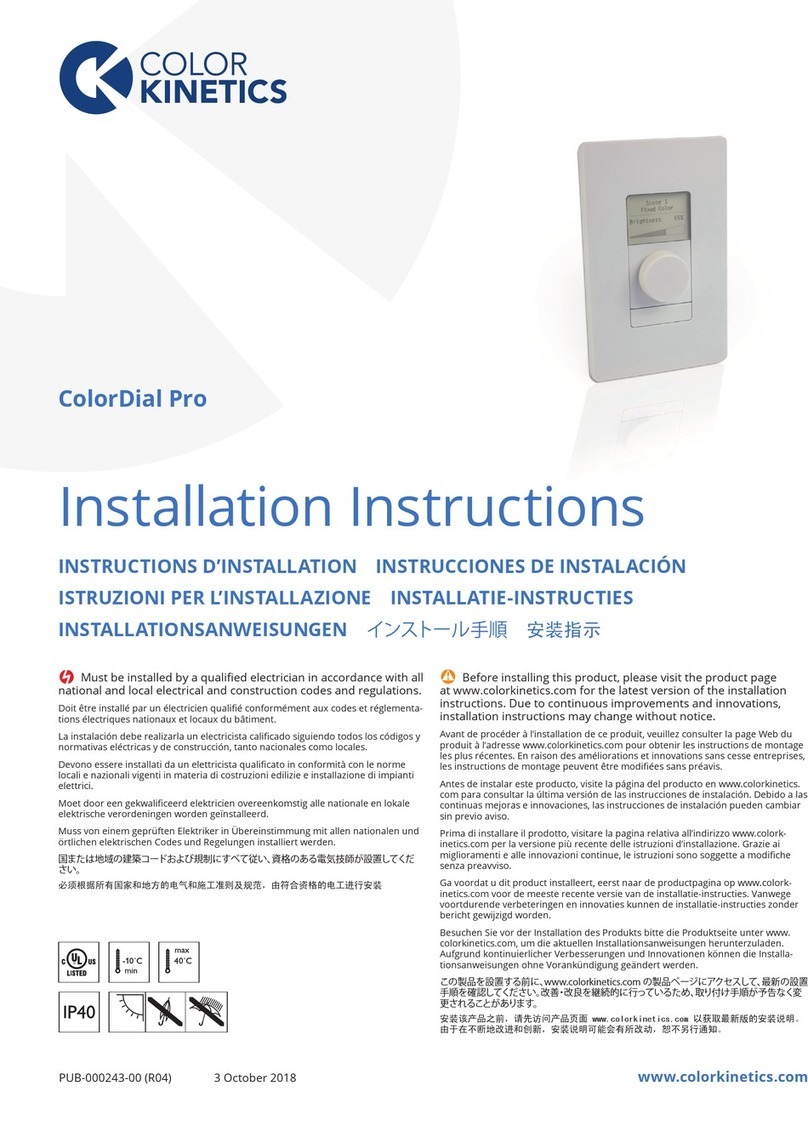
COLORKINETICS
COLORKINETICS ColorDial Pro installation instructions

Atronix
Atronix X45/10 Installation and operating instructions
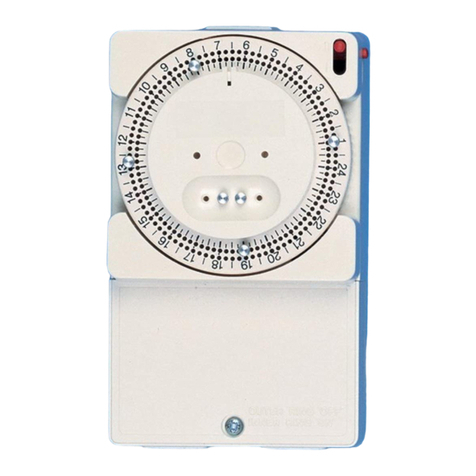
Timeguard
Timeguard TS900B operating instructions

Show Tec
Show Tec PLE-30-040 user manual

SMART-AVI
SMART-AVI EZ-WALL 2X2L user manual
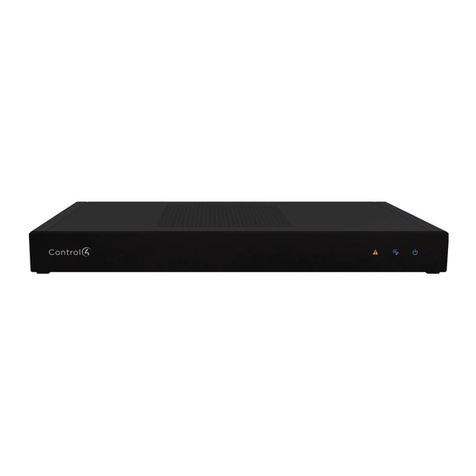
Contro l4
Contro l4 C4-EA5 installation guide
